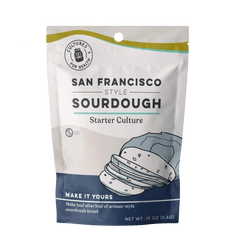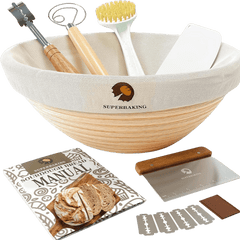Sourdough bread is a time-honored tradition dating back thousands of years. It owes its unique flavor and leavening properties to naturally occurring wild yeast and lactic acid bacteria, present in the environment. This dynamic duo forms a symbiotic relationship, giving rise to the characteristic tang and chewy texture that sets sourdough apart from other bread varieties.
Taylor Swift’s Sourdough Era

How to Make Sourdough Bread Like a Boss
Any sourdough bread starts with a starter. Instead of using store bought yeast like a normal loaf of bread, sourdough bread relies on a living culture of yeasts that you grow at home. We love the extra tang of our Culture of Health San Francisco Sourdough Starter. A sourdough starter is just your own colony of wild yeast and each colony can have it own flavor. Giving this starter some time to digest and leaven your dough will produce the sour flavor that's the calling card of sourdough bread.
Recipe from Cultures For Health
Ingredients:
2 1/3 cups fresh sourdough starter
3 1/3 cup flour
1-1 1/2 cup water
Scant Tbsp. salt
Sourdough bread is packed with prebiotics that are good for your gut health, and its slow fermentation process gives the bread a lower glycemic index.
Instructions
Mix sourdough starter, flour, and salt together. Use enough water to make bread dough. A moist dough is preferable to a dry dough. Because of difference in hydration and humidity, it's difficult to give and exact amount of water to use, but as you make a few loaves, you'll get a feel for when the sourdough feels ready to work with.
Knead dough until it passes the “window pane test”: a small piece of dough will stretch between four fingers without breaking thin enough to allow light to pass through. This can be done via a whole bunch of methods, both by hand and with a stand mixer. One common method for kneading sourdough bread is to grab the dough, pull it and fold it over, rotate the sourdough 90 degrees and do it again. Repeating this folding will help build the gluten strands that will produce the light and airy structure as the dough rises.
Shape the dough into a loaf. Place in a pan or proofing basket, or on a board. Rub a little oil on the top surface of the dough and cover lightly with a towel or plastic wrap. Allow the dough to rise for 4-24 hours. If desired, a short (4-12 hours) proofing period can be used and the dough can be punched down, reshaped, and allowed to rise a second time, but a second proofing period is not required.
Slice an X shape in the top of the loaf with a very sharp knife or razor blade. As the bread bakes, the air inside will expand, giving the sourdough some additional loft. However, that expansion can split the bread. By using a razor to provide a place for that expansion, we can minimize the risk of the bread doing something unexpected as it cooks.
Bake at 400°F until the internal temperature reaches 210°F. (Use a meat thermometer inserted into the bottom or side of the loaf.) Bake 30-60 minutes (depending on loaf size).
Cool before slicing. Yes, let it cool before slicing. I know, everyone wants fresh, warm sourdough, but the bread will be better if you let it cool first!
Tweak Your Recipe :
Now that you've made a loaf, one thing you'll notice is that this recipe is more of an outline than an exact recipe. If you use more water and make a wetter dough, you'll get a little different texture. If you let it proof longer, that sour flavor will intensify. Cooking in a dutch oven will result is a thicker crust. And there are a dozen other tweaks you can make to make the sourdough recipe your own.
Once you've created a bread that you love, you'll be able to recreate it and share it with friends and family. There's nothing quite like sharing a homemade sourdough bread with friends who recognize and love the unique flavor that only your sourdough bread brings to the table!
Taylor Swift Inspired Lemon Blueberry Sourdough Bread

To transform your sourdough bread recipe into a Taylor Swift Inspired Lemon Blueberry Sourdough Bread, you can follow these steps:
Add Fresh Blueberries
Very gently fold in 1-1.5 cups of fresh blueberries into the dough during the stretch and folds to evenly distribute them throughout the dough. Make sure not to crush them too much to maintain the texture of the blueberries in the final bread.
Incorporate Lemon Zest
Add the zest of 1-2 lemons into the dough when mixing. The lemon zest will infuse the bread with a bright, citrus flavor.
Adjust the Liquid
When incorporating the lemon zest, you may need to slightly adjust the amount of water depending on the consistency of the dough. Start with the lower end of water (1 cup) and gradually add more if needed to achieve the desired dough texture.
Bake as Usual
Follow the original baking instructions. The blueberries and lemon zest will bring a delightful aroma and flavor to your sourdough bread.
With these adjustments, you will have a delicious Lemon Blueberry Sourdough Bread that combines the tangy sourdough flavor with the sweetness of blueberries.
Now that we've explored the wonders of sourdough bread and checked out a recipe, are you feeling inspired to try your hand at baking your very own loaf? If so, you're in luck! I've curated a list of essential tools and ingredients to help kickstart your sourdough adventure.
Check out these must-haves to get started:
KneadAce Pro Glass Sourdough Bread Starter Kit

A glass jar with a funnel-shaped opening enables effortless handling. Comes with a silicon cover for fridge storage that doubles as unti-slip base for your kitchen counter during fermentation while using the cloth cover. It also comes complete with volume, net weight & feed line marks, thermometer, cloth cover and perfectly shaped silicone spatula. You use an elastic band marked with the days of the week gives you an accurate indication of when you last fed your sour dough starter and the feeding level.

Cultures for Health San Francisco Style Starter Culture
Cultures for Health's San Francisco style starter has proven itself very versatile and hardy, happily thriving in a variety of environments to continually produce chewy, crusty, tangy sourdough loaves. If you're going for authentic, go for the San Francisco Style culture.
Superbaking Bread Proofing Basket and Starter Kit.

This highly rated kit includes six tools and a 9 inch proofing basket.
These carefully selected items will not only make your sourdough baking experience more enjoyable but will also set you on the path to creating delicious, artisanal

Enameled Cast Iron Dutch Oven Bread Baking Kit
The bread Dutch oven with lid is perfect for baking sourdough and homemade sandwich loaves with crispy crusts and soft interior; beyond baking bread, this cast iron bread pan is also perfect for slow-cooking, simmering, braising, baking, Boiling, or roasting a wide range of recipes.
Baked Goods Bags with Gift Tags

These paper bread bags are made of high quality food grade kraft paper. They are equipped with Handmade stickers, this provides a strong seal that is dustproof and moisture-proof, keeping your food fresh and delicious for longer.
Happy baking!
Amazon Affiliate Disclosure: At no cost to you, as an Amazon Associate I earn a small commission from qualifying purchases when you purchase from the above links. I carefully curate these items as relevant and valuable to readers in relation to the blog post and I never accept free products to feature in links.


